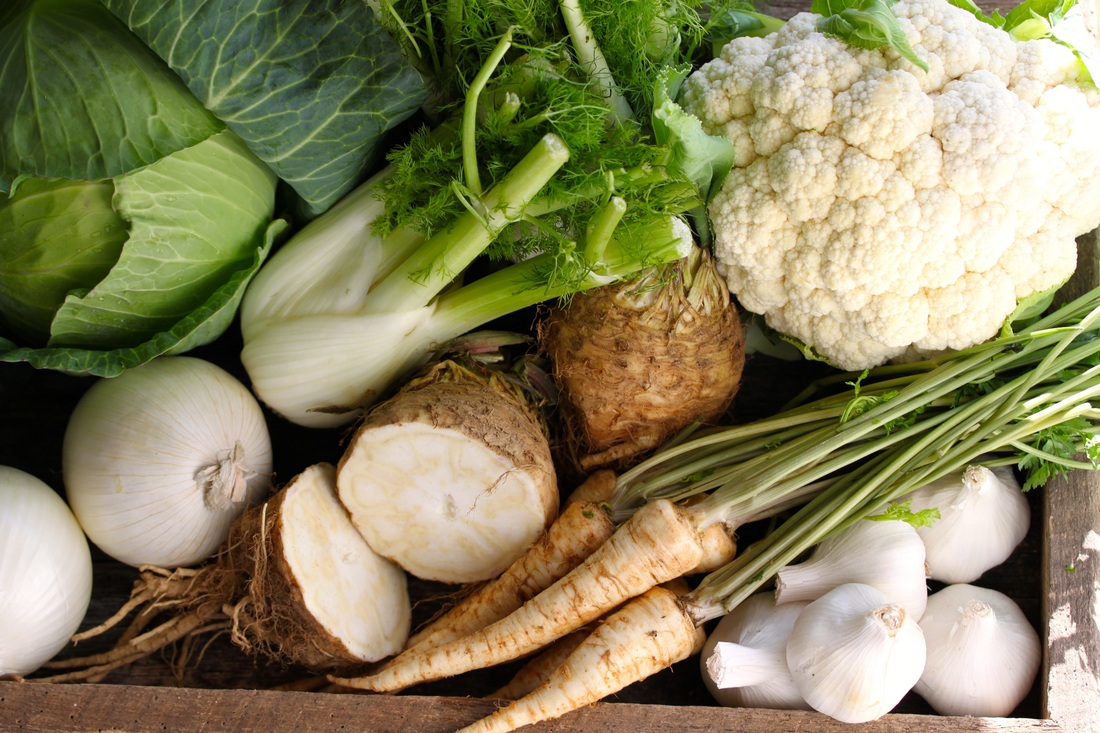Why have we forgotten about white vegetables? Maybe it is due to the misguided, nutritional advice such as ‘avoid all white foods’, ‘only eat green vegetables’ and ‘the more colourful the food the more nutritious’. But white vegetables are just as nutritious as their colourful friends. Each vegetable contains its own set of specific vitamins, minerals, phytochemicals and health benefits including the white ones! The colour of vegetables are not necessarily a guide to nutrient or phytochemical content (phytochemical – a component in plants which is responsible for some of their health benefits). Some of the phytochemicals in vegetables are coloured such as carotenoids (yellow to red), chlorophylls (green) and anthocyanins (blue, purple, red) however others such as flavonoids and polyphenolds are colorless and can be found in white vegetables.
Cauliflower and turnips are cruciferous vegetables. They are full of fibre as well as vitamins A, B, C and K. Cruciferous vegetables contain antioxidants, phytochemicals, Indole-3-carbinol and isothiocyanates which have anticancer properties. Numerous studies have been done on these vegetables and their links with cancer prevention. Although the mechanisms behind their action are not fully understood there are promising results to show a positive relationship with these veggies and cancer protection. Cauliflowers and turnips are low in calories, high in fibre and have a high nutritional density. Boiling these vegetables reduces the nutritional content of them so lightly steaming, microwaving or stir frying is the best cooking method.
Mushrooms are nutrient dense and packed full of nutrition for very little calories. 100g of mushrooms contains around 38 calories. Mushrooms provide a variety of nutrients and antioxidants such as B vitamins including folate and biotin as well as copper and selenium. When exposed to sunlight mushrooms naturally produce vitamin D making them one of the few food sources of vitamin D. Despite popular belief mushroom are not a great source of vitamin B12. Most of the B12 is found on the outer peel which is most likely bacteria derived. Mushrooms are nutrient dense, high in fibre and are a great addition to the diet.
Onions, you may shed a tear when cutting them but they should be tears of joy because of the fabulous nutritional content of them. The compound allul sulphate is responsible for irritating the eyes when the onion cell is ruptured and exposed to air. Chilling onions in the fridge for half an hour before cutting them can help reduce the enzyme activity. Onions are very low in calories with one large onion providing about 60 calories as well as vitamin C, B6, fibre, antioxidants and flavonoids. Onions have been used for thousands of years for medicinal uses. Research is also confirming their health benefits with one study linking moderate consumption of onions to a reduced the risk of colorectal, laryngeal and ovarian cancers. Onions have also been linked to reducing LDL cholesterol, increasing good HDL cholesterol and reducing high blood pressure.
Potatoes are a good source of carbohydrates, fibre and resistant starch and are a staple food in many cultures. Potatoes have been shunned by many people due to their link with weight gain and high carbohydrate content. Potatoes do contain more calories (about 77 calories per 100g) and are higher in carbohydrates than many other vegetables but they can certainly be included as part of a healthy balanced diet. Even though they contain a higher calorie content compared to other vegetables they are still low in calories, have a high nutritional value and therefore can be included in weight loss diets. Of course the cooking method is crucial and any added fats or oils will increase the calorie content. Potatoes are a good source of vitamin C, potassium, magnesium, and vitamin B-6. Boiling potatoes can reduce the nutritional value and ensure you eat the skin as it contains a lot of nutrition and fibre.
So do not discriminate! All vegetables are packed full of nutrition, fibre, vitamins, minerals and phytochemicals. Try and eat a rainbow of vegetables including white ones so you can obtain all of the health benefits that each individual vegetable contains.

You’ve inspired me to go out and buy some cauliflower and try it out again. I don’t know why I ever stopped liking cauliflower, because I always ate it as a kid, but for some reason I stopped buying it. But I do have to say that my favourite white foods are mushrooms, very closely followed by fennel.
LikeLike
So glad to hear it has inspired you to buy some cauliflower! Here is a great recipe for ‘popcorn cauli’ I haven’t tried it yet but it looks yum! http://www.pinterest.com/pin/158963061821492004/ I love mushrooms too but I don’t eat much fennel, I’ll definitely get back onto it though 🙂
LikeLike
That’s exactly the type of thing I wanted to try. You’ve just saved me time hunting for a recipe – thanks!
LikeLike
Great topic for a post- it had never occurred to me that white vegetables are overlooked, but when you look at dietary advice like that “the more colourful, the better”, the issue of misinformation becomes obvious! Allium vegetables are one of the food groups with the strongest evidence for cancer prevention, which is often not mentioned.
LikeLike